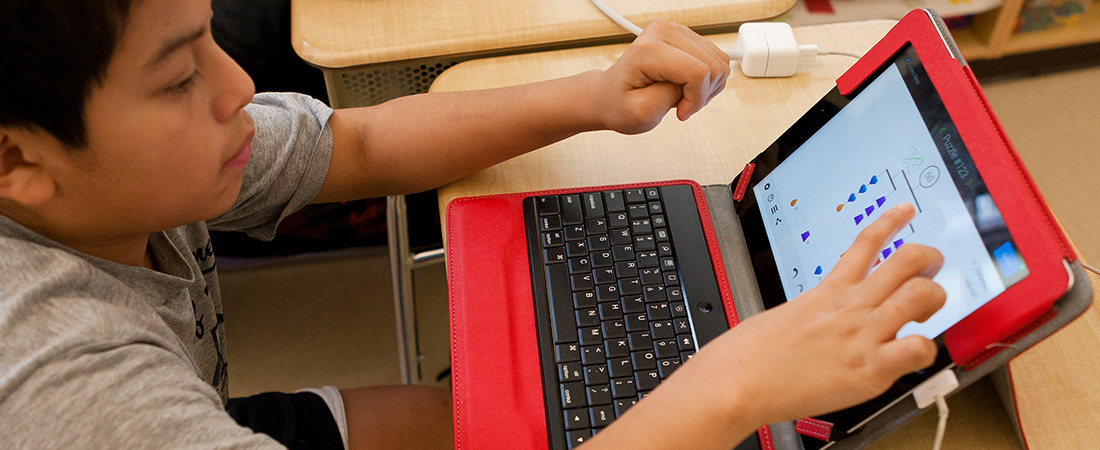Puzzling, and Learning

Students use EDC's SolveMe Mobiles app to learn mathematics—and have fun.
Tap, tap, tap. The student’s fingers float across her iPad, tapping the device in a staccato rhythm. She pauses to look at the simple mobile structure displayed on the screen. It is made of squares, triangles, and stars, each shape a different color, all hanging underneath the number 30. She taps again, assigning a numerical value to one of the shapes. The structure tilts, unbalanced. She tries again. This time, her solution works—the mobile regains its balance—and a short message of encouragement pops up.
“Yes,” she says softly, before moving on to the next problem. Tap, tap, tap.
Around the room, 22 other sixth graders from McDevitt Middle School in Waltham, Massachusetts, are using their iPads to solve similar mathematical puzzles. They are some of the first students to use an algebra-infused, mathematically inspired iPad app called SolveMe Mobiles, developed at EDC.
At the periphery of the room, EDC’s Mary Fries watches with interest as the students interact with the puzzles and with each other. For the past 24 months, she has been the lead developer of the team that has created, tested, piloted, and debugged the puzzles. Now she is in the home stretch, only a couple months away from seeing the final version of SolveMe Mobiles go live on Apple’s App Store and on the Web.
“I’m watching to see what their approach is, where they are getting stuck, and what parts of the app they engage in,” says Fries. “We’re still looking for bugs, but we are also looking for ways to make the mathematics more accessible, too.”
Making mathematics fun
At its core, SolveMe Mobiles is a series of increasingly challenging puzzles that help students build the logical reasoning needed for algebra. But first and foremost, SolveMe Mobiles is a game, and it is designed to be fun.
Students using SolveMe Mobiles must find the value of different shapes based on their placements within a colorful mobile. Students have some information to go on, including the shapes’ relationships with other known values, and (sometimes) the total weight of the mobile itself. Players also have the opportunity to build and share their own puzzles with the larger SolveMe Mobiles community.
Fries says that the process students perform as they solve the puzzles is identical to the process needed for solving a system of algebraic equations, and that the app helps students build the logical reasoning needed to understand the algebraic process.
And by helping students learn how to make sense of and persevere through problems that may, at first, seem unfamiliar, SolveMe Mobiles is well-aligned with the new Common Core Standards for Mathematical Practice, which stress higher-order mathematical thinking.
SolveMe Mobiles extends EDC’s innovative use of puzzles to help students build algebraic habits of mind, an approach first pioneered in EDC’s Transition to Algebra curriculum. It’s an approach that is motivating students.
“Because these puzzles are engaging, students develop the persistence and stamina to solve problems,” says EDC’s June Mark, project director and co-author of Transition to Algebra. “Real problems require students to figure out where to start and what to do next. Puzzles are a natural context for doing that.”
But the transition from paper to iPad presented some unique challenges.
“We found out early on that solving a puzzle in an app is different than solving one on paper,” says Fries. “We found students doing things that we hadn’t deliberately designed in the app. They were trying to grab the mobiles and move things out of the way, actions that we hadn’t considered in the first versions of the app.”
Transforming learning
The next day, Fries continues her observations at Bigelow Middle School in Newton, Massachusetts. Here students are using the Web-based version of SolveMe Mobiles. The tapping of fingers on iPads has been replaced by quiet mouse clicks.
Fries approaches two girls; one of them has created an elaborate puzzle of her own, with many shapes hanging off multiple branches. Fries asks the girl if she has solved the problem herself, and whether she has shared it with her partner.
“Yes,” comes the reply.
This turns out to be an important finding.
“I was glad to see two girls create a solvable puzzle—and then solve it,” says Fries. “Often students will create puzzles that are not solvable or that do not have a unique solution. We actually changed the sharing function so that you can only share a problem once you have solved it yourself.”
As in Waltham, students in Newton seem to enjoy the puzzles. One girl says that they make her think. “Not hard-core thinking,” she adds as a qualifier, “but still thinking.”
And her friend? She says that she would solve the puzzles at home—just for fun.